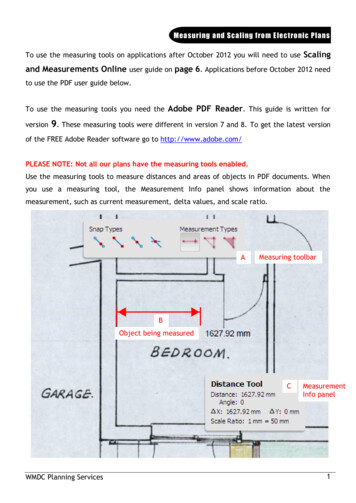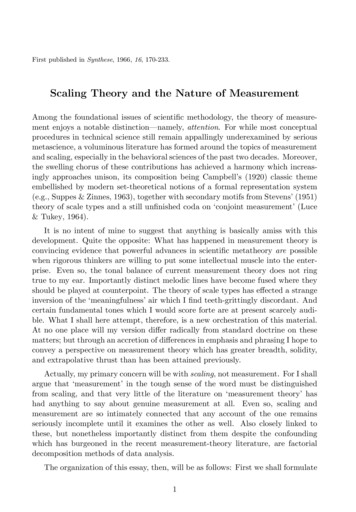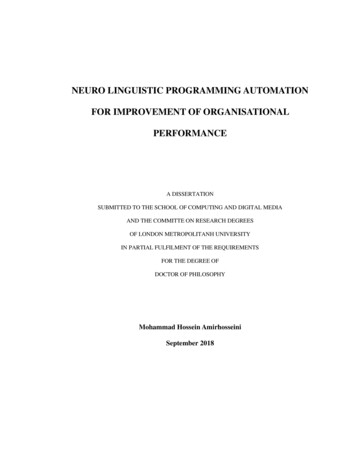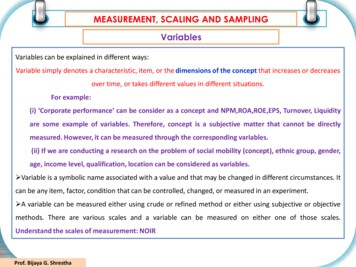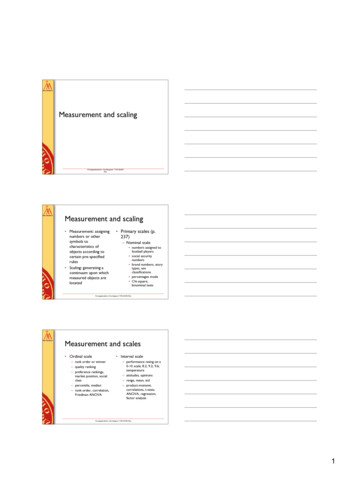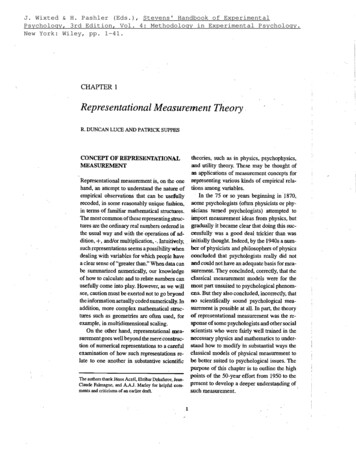
Transcription
J. Wixted & H. Pashler (Eds.), Stevens' Handbook of ExperimentalPsychology, 3rd Edition, Vol. 4: Methodology in Experimental Psychology.New York: Wiley, pp. 1-41.CHAPTER 1Representational Measurement Theory .R. DUNCAN LUCE AND PATRICK SUPPEStheories, such as in physics, psychophysics,and utility theory. These may be thought ofas applications of measurement concepts forRepresentational measurement is, on the -one representing various kinds of empirical relahand, an attempt to understand the nature of tions among variables.In the 75 or so years beginning in 1870,empirical observations that can be usefullyrecoded, in some reasonably unique fashion, some psychologists (often physicists or phyin terms of familiar mathematical structures. sicians turned psychologists) attempted toThe most common of these representing struc- import measurement ideas from physics, buttures are the ordinary real numbers ordered in gradually it became clear that doing this sucthe usual way and with the operations of ad- cessfully was a good deal trickier than wasdition, , andlor multiplication, . Intuitively, . initially thought. Indeed, by the 1940s a numsuch representatious seems a possibility when ber of physicists and philosophers of physicsdealing with variables for which people have concluded that psychologists really did nota clear sense of "greater than." When data can and could not have an adequate basis for meabe summarized numerically, our knowledge surement. They concluded, correctly, that theof how to calculate and to relate numbers can classical measurement models were for theusefully come into play. However, as we will most part unsuited to psychological phenomsee, caution must be exerted not to go beyond ena. But they also concluded, incorrectly, thatthe information actually coded numerically. In no scientificaJIy sound psychological meaaddition, more complex mathematical struc- surement is possible at all. In part, the theorytures such as geometries are often used, for of representational measurement was th re- 'sponse of some psychologists and other socialexample, in multidimensional scaling.On the other hand, representational mea- scientists who were fairly well trained in thesurement goes well beyond the mereconstruc- necessary physics and mathematics to undertion of numerical representations to a careful stand how to modify in substantial ways theexamination of how such representations re- classical models of physical measurement tolate to one another in substantive scientific be better suited to psychological issues. Thepurpose of this chapter is to outline the highpoints of the 50-year effort from 1950 to theThe authors thank Janos Aczel. Ehtibar Dzhafarov. Jeanpresent to develop a deeper understanding ofClaude Falmagne, and A.AJ. Marley for helpful comments and criticisms of an earlier draft.such measurement.CONCEPT OF REPRESENTATIONALMEASUREMENT1
2 Representational Measurement Theory·Empirical StructuresPerforming any experiment, in particular apsychological one, is a complex activity thatwe never analyze or report completely. Thepart that we analyze systematically and report on is sometimes called a model of thedata or, in terms that are useful in the theory of measurement, an empirical structure.Such an empirical structure of an experimentis a drastic reduction of the entire experimental activity. In the simplest, purely psy-.chological cases, we represent the empiricalmodel as a set of stimuli, a set of responses,'and some relations observed to hold betweenthe stimuli and responses. (Such an empiricalrestriction to stimuli and responses does notmean that the theoretical considerations areso restricted; unobservable concepts may wellplaya role in theory.) In many psychologicalmeasurement experiments such an empiricalstructure consists of a set of stimuli that varyalong a single dimension, for example, a setof sounds varying only in intensity. We mightthen record the pairwise judgments of loudness by a binary relation on the set of stimuli,where the first member of a pair representsthe subject's jndgment of which of two soundswas louder:The use of such empirical structures inpsychology is widespread because they comeclose to the way data are organized for subsequent statistical analysis or for testing a theoryor hypothesis.An important cluster of objections to theconcept of empirical structures or models ofdata exists. One is that the formal analysisof empirical structures includes only a smallportion of the many problems of experimental design. Among these are issues such asthe randomization of responses between leftand right hands and symmetry conditions inthe lighting of visual stimuli. For example, inmost experiments that study aspects of vision,having considerably more intense light on theleft side of the subject than on the rigbt wouldbe considered a mistake. Such considerationsdo not ordinariI y enter into any formal description of the experiment.· This is just thebeginning. There are understood conditionsthat are assumed to hold but are not enumer·ated: Sudden loud noises did not interfere withthe concentration of the subjects, and neitherthe experimenter talked to the subject nor thesubject to the experimenter during the collection of the data-although exceptions to thisrule can certainly be found, especially in linguistically oriented experiments.The concept of empirical structures is justmeant to isolate the part of the experimentalactivity and the form of the data relevant tothe hypothesis or theory being tested or to themeasurements being made.Isomorphic StrncturesThe prehistory of mathematics, beforeBabylonian, Chinese, or Egyptian civiliza-tions began, left no written record but nonetheless had as a major development the concept of number. In particular, counting ofsmall collections of objects was present. Oralterms for some sort of counting seem to existin every language. The next big step was theintroduction, no doubt independently in several places, of a written notation for numbers.It was a feat of great abstraction to developthe general theory of the constructive operations of counting, adding, subtracting, multiplying, and Ilividing numbers. The first problem for a theory of measurement was to showhow this arithmetic of numbers could be constructed and applied to a variety of empiricalstructures.To investigate this problem, as we do inthe next section, we need the general notion of isomorphism between two structures.The intuitive idea is straightforward: Twostructures are isomorphic when they exhibitthe same structure from the standpoint of
Concept of Representational Measurement 3their basic concepts. The point of the fonnaldefinition of isomorphism is to make this notion of same structure precise.As an elementary example, consider abinary relational structure consisting of anonempty set A and a binary relation R defined on this set. We will be considering pairsof such structures in which both may be empirical structures, both may be numerical structures, or one may be empirical and the othernumerical. The definition of isomorphism isunaffected by which combination is beingconsidered.The way we make the concept of havingthe same structure precise is to require the ex. istence of a function mapping the one structure onto the other that preserves the binaryrelation. Fonnally, a binary relation structure(A, R) is isomorphic to a binary relation structure (A', R') if and only if there is a functionfsuch that(i) the domain of f is A and the codomainof f is A', i.e., A' is the image of AunderJ,(ii) fis a one-one function,' and(iii) fora and b inA,aRbiff 2 f(a)R'f(b).To illustrate this definition of isomorphism, consider the question: Are any two finitebinary relation structures with the same number of elements isomorphic? Intuitively, itseems clear that the answer should be negative, because in one of the structures all theobjects could stand in the relation R to eachother and not so in the other. This is indeedthe case and shows at once, as intended, thatisomorphism depends not just on a one-onefunction from one set to another, but alsoon the structure as represented in the binaryrelation.Ordered Relational StrncturesWeak OrderAn idea basic to measurement.is that the objects being measured exhibit a qualitative attribute 'for which it makes sense to ask thequestion: Which of two objects exhibits moreof the attribute, or do they exhibit it to the samedegree? For example, the attribute of havinggreater mass is reflected by placing the twoobjects on the pans of an equal-arm pan balance and observing which deflects downward.The attribute ofloudness is reflected by whichof two sounds a subject deems as louder orequally loud. Thus, the focus of measurementis not just on the numerical representation ofany relational structures, but of ordered ones,that is, ones for which one of the relations is aweak order, denoted , which has two defining properties for all elements a, b, c in thedomain A:(i) Transitive: if a b and b c, then a c.(ii) Connected: either a b or b !::; a or both.The intuitive idea is that!::; captures the ordering of the attribute that we are attempting tomeasure.1\\'0 distinct relations can be defined intenns of!::;:a - biff a b and not (b!::;a);a b iff both o!::; b and b a .It is an easy ex rcise to show that - is transitive and irreflexive (i.e., a - 0 cannOt hold),and that is an equivalence relation (i.e.,btransitive. symmetric in the sense that aiff b a, and reflexive in the sense thata 0). The latter means that partitions Ainto equivalence classes.""VHomomorphism.For most measurement situations one reallyis working with weak orders-after all, twoI In recent years, conditions (i) and (ii) together haveentitieshaving the same weight are not in gen- .come to be called bijective.2This is a standard abbreviation for "if and only jf:'eral identical. But often it is mathematically
4Representational Measurement Theoryeasier to work with isomorphisms to the ordered real numbers, in which case one mustdeal with the following concept of simple orders. We do this by inducing the preferenceorder over the equivalence classes defined by"". When""'" is . each element is an equivalence class, and the weak order::: is called asimple order. The mapping from the weaklyordered structure via the isomorphisms ofthe (mutually disjoint) equivalences classesto the ordered real numbers is called a homomorphism. Unlike an isomorphism, whichis one to one, an homomorphism is many toone. In some cases, such as additive conjointm"easurement, discussed later, it is somewhatdifficult, although possible, to formulate thetheory using the equivalence classes.fuo Fundamental Problemsof Representational Measurementpassing from the empirical to the numericalis necessary for precise prediction or controlof phenomena. Of course, such a representation is useful only to the extent of the precisionof the observations on which itis based. A variety of numerical representations for variousempirical psychological phenomena is givenin the sections that follow.UniquenessThe second fundamental problem of representational measurement is to discover theuniqueness of the representations. Solving therepresentation problem for a theory of measnrement is not enough. There is usually aformal difference between the kind of assignmeIit of numbers arising from different procedures of measurement. as may be seen inthree intuitive examples:. 1. The populati on of California is greater thanthat of New York.Existence2. Mary is 10 years older than John.The most fundamental problem for a theory ofrepresentational measurement is to constructthe following representation: Given an empirical structure satisfying certain properties, towhich numerical structures, if any, is it isomorphic? These numerical structures, thus,represent the empirical one. It is the existenceof such isomorphisms that constitutes therepresentational claim that measurement ofa fundamental kind has taken place.Quantification or measnrement, in thesense just characterized, is important in someway in all empirical sciences. The primarysignificance of this fact is that given the isomorphism of Structures, we may pass from theparticular empirical structure to the numericalone and then use all our familiar computational methods, as applied to the isomorphicarithmetical structure, to infer facts about theisomorphic empirical structure. Such passagefrom simple qUalitative observations to quantitative ones-the isomorphism of structures3. The temperature in New York City thisafternoon will be 92 OF.Here we may easily distinguish three kindsof measurements. The first is an example ofcounting, which is an absolute scale. Thenumber of members of a given collection thatis counted is determined uniquely in the idealcase, a1\h iugh that Can be difficult in practice (wituess the 2000 presidential electionin Florida). In contrast, the second example,the measurement of difference in age, is aratio scale. Empirical procedures for measuring age do not determine the unit of age-chosen in the example 10 be the year ratherthan, for example, the month or the week.Although the choice of the unit of a person's age is arbitrary-that is. not empirically prescribed-that of the zero, birth, isnot. Thus, the ratio of the ages of any two people is independent of its choice. and the ageof people is an example of a ratio scale. The
A Brief History of Measurement 5"measurement of distance is another example with incommensurables: "Those magnitudesof such a ratio scale. The third example, that are said to be cOminensurable which are meaof temperature, is an example of an interval sured by the same measure, and those incomscale. The empirical procedure of measuring mensurable which cannot have any commontemperature by use of a standard thermometer measure" (trans. 1956, p. 10).or other device determines neither a unit norlt does not take much investigation to determine that theories and practices relevant toan origin.We may thus also describe the second fun- measurement occur throughout the centuriesdamental problem for representational mea- in many different contexts. lt is impossiblesurement as that of detennining the scale type to give details here, bnt we mention a fewof the measurements resulting from a given salient examples. The first is the discussion" of the measurement of pleasure and pain inprocedure.Plato's dialogue Protagoras. The second isthe set of partial quaJ.itative axioms, characterA.BRIEF HISTORYizing in our tenns empirical structures, givenOF MEASUREMENTby Archimedes for measuring on unequal balances (Suppes, 1980). Here the two qualitativePre-19th-Century Measurementconcepts are the distance from the focal pointAlready by the fifth century B.C., if not before, of the balance and the weights of the objectsGreek geometers were.investigatillg problems placed in the two pans of the balance. Thiscentral to the nature of measurement. The is perhaps the first partial qualitative axiomGreek achievements in mathematics are all of atization of conjoint measurement, which isrelevance to measurement. First, the theory of discussed in more detail later. The third exnumber, meaning for them the theory of the' ample is the large medieval literature giving apositive integers, was closely connected with variety of qualitative axioms for the measurecounting; second, the geometric theory of pro- ment of weight (Moody and Claggett, 1952).portion was central to magnitudes that we now (psychologisis concerned about the difficultyrepresent by rational numbers ( ratios of in- of clarifying the measurement of fundamentegers); and, finally, the theory of incommen- ta! psychological quantities should be encoursurable geometric magnitudes fo those mag- aged by reading O'Brien's 1981 detailed exnitudes that could not be represeuted by ratios. position of the confused theories of weight inThe famous proof of the irrationaJ.ity of the the ancient world.) The fourth example is thesquare root of two seems arithmetic in spirit detailed discussion of intensive quantities byto us, but almost certainly the Greek discov- Nicole Oresme in the 14th century A.D. Theery of incommensurability was geometric in fifth is GaIileo's successful geometrization incharacter, namely, that the length of the di- the 17th century of the motion of heavenlyagonal of a square, or the hypotenuse of an . bodies, done in the context of stating essen':'isosceles right-angled triangle, was not com- tially qualitative axioms for what, in the earmensurable with the sides. The Greeks well lier tradition, would be called the quantity ofunderstood that the varions kinds of results motion. The final example is also perhaps thejust described applied in general to magni- last great, magnificent, original treatise ofnattudes and not in any sense only to numbers ural science written wholly in the geometricalor even only to the length of line segments. tradition-Newton's Principia of 1687. EvenThe spirit of this may be seen in the first def- in his famous three laws CJif motion, conceptsinition of Book 10 of Euclid, the one dealing were formulated in a qualitative, geometrical
6 Representational Measurement Theoryway, characteristic of the later formulation ofqualitative axioms of measurement.19th- and Early 20th-CenturyPhysical MeasurementThe most important early 19th-century workon measurement was the abstract theory ofextensive quantities published in 1844 byH. Grassmann, Die Wissenschaft der Extensiven Grosse oderdieAusdehnungslehre. Thisabstract and forbidding treatise, not properlyappreciated by mathematicians at the timeof its appearance" contained at this earlydate the important generalization of the concept' of geometric extensive quantities ton-dimensional vector spaces and, thus, to theaddition, for example, of n-dimensional vectors. Grassmann also developed for the firsttime a theory of barycentric coordinates in ndimensions, It is now recognized thatthis wasthe first general and abstract theory of extensive quantities to be treated in a comprehensive manner.Extensive MeasurementDespite the precedent of the massive workof Grassmann, it is fair to say that the modem theory of one-dimensional, extensive measurement originated much later in the century with the fundamental work of Helmholtz(1887) and HOlder (1901). The two fundamental concepts of these first modem attempts, and later ones as well, is a binaryoperation 0 of combination and an orderingrelation i'::;, each of which has different interpretations in different empirical structures.For example, mao;;s ordering J: is detenninedby an equal-arm pan balance (in a vacuum)with a ob denoting objects a and b both placedon olie pan: Lengths of rods are ordered byplacing them side-hy-side, adjusting one endto agree, and determining which rod extendsbeyond the other at the opposite end, and 0means abutting two rods along a straight line.The ways in which the basic axioms can bestated to describe the intertwining of these twoconcepts has a long history of later development. In every case, however, the fundamentalisomorphism condition is the following: Fora, b in the empirical domain,f(a) :::: f(b) # ai'::;b,f(a0b) f(a)(I) !(b),(2)where ! is the mapping function from theempirical structure to the numerical structureof the additive, positive real numbers, that is,for all entities a, !(a) O.Certain necessary empirical (testable)properties must be satisfied for such a representation to hold. Among them are for allentities a, b, and c,Commutativity: a 0 b boa.Associativity: (a 0 b) 0 c a 0 (b 0 c).Monotonicity: a,t b {} a 0 c.?: b 0 c.Positivity: a 0 a - a.Let a be any element. Define a standardsequence based on a to be a sequence a(n),where n is an integer, such that a(1) a,and for i I, a(i) a(i -I) o'a. An exampleof such a standard sequence is the centimetermarks on a meter ruler. The idea is that theelements of a standard sequence are equallyspaced. The following (not directly testable)condition ensures that the stimuli are commensurable:Archimedean: For any entities a, b,there is an integer n such that a (n) b.These, together with the following structural condition that ensures very small elements,Solvability: if a b,then for some c, a - b0 C,were shown to imply the existence of the representation given by Equations (1) and (2).By formulating the Archimedean axiom differently, Roberts and Luce (1968) showed thatthe solvability axiom could be elintinated.
A Brief History of Measurement 7Such empirical structures are called extensive. The uniqueness of their representationsis discussed shortly.Probability and Partial OperationsIt is well known that probability P is an additive measure in the sense that it maps eventsinto [0. I] such that, for events A and B thatare disjoint,P(A U B) P(A) P(B).Thus, probability is close to extensive measurement-but not quite, because the operation is limited to only disjoint events. How ver, the theory of extensive measurement canbe generalized to partial operations having theproperty that if a and b are such that a 0 b isdefined and if a.t c and b.t d, then cod isalso defined. With some adaptation,. this canbe applied to probability; the details.can befound in Chapter 3 of,Krantz, Luce, Suppes,and Tversky (1971). (This reference is subsequently cited as FM I for Volume I of Foundations of Measurement. The other volumesare Suppes, Krantz, Lnce, & Tversky, 1990,cited as FM n, and Luce, Krantz, Suppes, &Tversky, 1990, cited as FM ill.)Finite Partial Extensive StructuresContinuing with the theme of partial operation, we describe a recent treatment of a finiteextensive structure that also has ratio scalerepresentation and that is fully in the spirit ofthe earlier work involving continuous models.Suppose X is a finite set of physical objects,any two of which balance on an equal-armbalance; that is, if at, . ,an are the objects,for any i and j, i I' j, then a, a j. Thus, theyweigh the sarne. Moreover, if A and B are twosets of these objects, then on the balance wehave A B if and only if A and B have thesarne number of objects. We also have a concatenation operation, union of disjoint sets. IfA n B 0, then A U B C if and only ifthe objects in C balance the objects in Atogether with the objects in B. The qualitativestrict ordering A - B has an obvious operational meaning, which is that the objects inA, taken together, weigh more on the balancethan the objects in B, taken together.This simple setup is adequate to establish,by fundamental measurement, a scheme fornumerically weighing other objects not in X.First, our homomorphism f on X is reallysimple. Since for all ai and aj and X, ai . a j,we havef(a,) f(aj),with the restriction that f(a,) O. We extendftoA,asubsetofX,bysettingf(A) IAI the cardinality of (number of objects in) A.The extensive structure is thus transparent:For A and B subsets of X, if A n B ::, 0 thenf(A U B) IA U BI IAI IBI f(A) f(B).If we multiply fby any a 0 the equationstill holds, as does the ordering. Moreover,in simple finite cases of extensive measurement such as the present, it is easy to prove directly that no transformations other than ratiotransformations are possible. Let /* denoteanother representation. For some object a, seta f(a)//*(a). Observe that if IAI n, thenby a finite inductionf(A)nf(a)-- --- af*(A)nf*(a),so the representation forms a ratio scale.Finite ProbabilityThe "objects" at . an are now interpretedas possible outcomes of a probabilistic mea-surement experiment, so the ajS are the possible atomic events whose qualitative probability is to be judged.The ordering A .t B is interpreted as meaning that event A is at least as probable as eventB; A B as A and B are equally' probable;A - B as A is strictly more probable than B.
8 Representational Measurement TheoryThen we would like to interpret f(A) as thenumerical probability of event A, but if f isunique np to only a ratio scale, this will notwork since f(A) could be 50.1, not exactly aprobability.By adding another concept, that of theprobabilistic independence of two events, wecan strengthen the nniqueness result to thatof an absolute scale. This is written A .l. B.Given a probability measure, the definition ofindependence is familiar: A .l. B if and only ifP(A n B) P(A)P(B). Independence cannot be defined in terms of the qualitative concepts introduced for arbitrary finite qualitativeprobability structures, but can be defined byextending the structure to elementary randomvariables (Suppes and Alecbina, 1994). However, a definition can be given for the special case in which all atoms are equiprobable; it again uses the cardinality of the sets:A.l.B if and only if IXI·IAnBI IAI·IBI.It immediately follows from this definitionthat X .l. X, whence in the interpretation of.l. we must haveP(X) P(X n X) P(X)P(X),but this equation is satisfied only if P(X) 0,which is impossible since P (0) 0 andX - 0,or P(X) I, which means that thescale type is an absolute-not a ratio--scale,as it should be for probability. Units and DimensionsAn important aspect of 19th century physicswas the development, starting with Fourier'swork (182211955), of an explicit theory ofunits and dimensions. This is so commonplace now in physics that it is hard to believe that it only really began at such a latedate. In Fourier's famolis work, devoted tothe theory of heat, he announced that in order to measure physical quantities and expressthem numerically, five different kinds of unitsof measurement were needed ' namely, thoseof length, time, mass, temperature, and heat.Of even greater importance is the specifictable he gave, for perhaps the first time in thehistory of physics, of the dimensions of various physical quantities. A modern version ofsuch a table appears at the end of FM 1.The importance of this tradition" of unitsand dimensions in the 19th century is to beseen in Maxwell's famous treatise on electricity and magnetism (1873). As a preliminary,he began with 26 numbered paragraphs onthe measurement of quantities because of theimportance he attached to problems of measurement in electricity and magnetism, a topicthat was virtually uliknown before the 19thcentury. Maxwell emphasized the fundamental character of the three fundamental nnitsof length, time, and mass. He then went onto derive units, and by this he meant quantities whose dimensions may be expressed interms of fundamental units (e.g., kinetic energy, whose dimension in the usual notation isM L 2T-2). Dimensional analysis, first put insystematic form by Fourier, is very useful inanalyzing the consistency of the use of quantities in equations and can also be nsed forwider purposes, which are discussed in somedetail in FM 1.Derived MeasurementIn the Fourier and Maxwell analyses, the question of how a derived quantity is actually to bemeasured does not enter into the discussion .What is important is its dimensions in terms offundamental units. Early in the 20th centurythe physicist Norman Campbell (1920/1957)used the distinctie",between fundamental andderived measurement in a sense more intrinsicto the theory of measurement itself. The distinction is the following: Fundamental measurement starts with qualitative statements(axioms) about empirical structures, such asthose given earlier for an extensive structure,and then proves the existence of a representational theorem in terms of numbers, whencethe phrase "representational measurement."
A Brief History of Measurement. 9In contrast, a derived quantity is measured interms of other fundamental measurements. Aclassical example is density, measured as theIt should be added that even in onedimensional geometry numerical representations arise even though there is no orderratio of separate measurements of mass andvolume. It is to be emphasized, of course, thatrelation. Indeed, for dimensions 2, no standard geometry has a weak order. Moreover, ingeometry the continuum is not important forthe fundamental Galilean and Lorentz groups.An underlying denumerable field of algebraicnumbers is quite adequate.calling density a derived measure with respectto mass and volume does not make a fundamental scientific claim. For example, it doesnot allege that fundamental measurement ofdensity is impossible. Nevertheless, in understanding the fooodations of measurement, itis always important to distinguish whetherfundamental or derived measurement, inCampbell's sense, is being analyzed or used., Axwmatic GeometryFrom the standpoint of representational measurement theory, another development ofgreat importance in the 19th century was theperfection of the axiomatic method in geometry, which grew out of the intense scrutinyof the foundations of geometry at the beginning of that century. The driving forcebehind this effort was undoubtedly the discovery and development of non-Euclidean geometries at the beginning of the century byBolyai, Lobachevski, and Gauss. An important and intuitive example, later in the century, was Pasch's (1882) discovery of the axiom named in his honor. He found a gap inEuclid that required a new axiom, namely, theassertion that if a line intersects one side of atriangle, it must intersect also a second side.More generally, it was the high level of rigorand abstraction of Pasch's 1882 book that wasthe most important step leading to the modem formal axiomatic conception of geometry,which has been so much a model for representational measurement theory in the 20thcentury. The most inlluential work in this lineof development was Hilbert's Grundlagen derGeometrie, first edition in 1899i much of itsprominence resulting from Hilbert's positionas one of the outstanding mathematicians ofthis period.lnvarianceAnother important development at the endof the 19th century was the creation of theexplicit theory of invariance for spatial properties. The intuitive idea is that the spatialpropert
J. Wixted & H. Pashler \(Eds.\), Stevens' Handbook of Experimental \rPsychology, 3rd Edition, Vol. 4: Methodology in Experimental Psychology.\rNew York: Wiley, pp. 1-41. 2 Representational Measurement Theory· Empirical Structures Performing any experiment, in p

